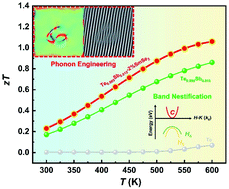High-performance p-type elemental Te thermoelectric materials enabled by the synergy of carrier tuning and phonon engineering†
Abstract
Elemental Te, as a promising mid-temperature thermoelectric material, has drawn much attention due to its distinctive band nestification and complex crystal structure. However, the poor doping efficiency and concomitant charge carrier scattering caused by the single doping/alloying method make it a challenging task to further optimize the thermoelectric performance. Herein, we demonstrate a multicomponent alloying strategy through introducing SmSe2 into a p-type Te matrix to realize the synergistic manipulation of carrier and phonon transport. This process has the following multi-functional effects: (i) precisely tuning the hole concentration to cover the optimal level; (ii) effectively weakening the reduced carrier mobility to maintain a high power factor, especially at elevated temperature; (iii) forming multi-dimensional lattice defects to enable a broad-frequency phonon scattering and consequently a noticeable suppression of lattice thermal conductivity; and (iv) improving the mechanical stability due to the pinning of dislocations. Ultimately, a high peak figure of merit zT of ∼1.06 at 600 K and an average zT as high as 0.69 (between 300 and 600 K) are achieved in Te0.985Sb0.015–2%SmSe2. The present work not only enriches the fundamental understanding on elemental Te, but also points to a new paradigm for advancing Te-related thermoelectrics with an intrinsically low thermal conductivity.



 Please wait while we load your content...
Please wait while we load your content...